Search Result
Results for "
diabetic mice
" in MedChemExpress (MCE) Product Catalog:
2
Isotope-Labeled Compounds
| Cat. No. |
Product Name |
Target |
Research Areas |
Chemical Structure |
-
- HY-131334
-
|
|
AMPK
|
Metabolic Disease
|
|
AMPK activator 4 is a potent AMPK activator without inhibition of mitochondrial complex I. AMPK activator 4 selectively activates AMPK in the muscle tissues. AMPK activator 4 dose-dependently improves glucose tolerance in normal mice, and significantly lowers fasting blood glucose level and ameliorates insulin resistance in db/db diabetic mice. Anti-hyperglycemic effect .
|
-

-
- HY-103290
-
|
|
Bradykinin Receptor
|
Others
|
|
R715 is a selective bradykinin B1 receptor antagonist. R715 significantly attenuates the hyperalgesic effect developed in Streptozotocin(HY-13753)-diabetic mice .
|
-

-
- HY-N7912
-
|
(2S)-Pterosin A
|
Others
|
Metabolic Disease
|
|
Pterosin A is an orally active anti-diabetic agent. Pterosin A promotes glucose uptake, increases serum insulin, and improves hyperglycemia and glucose intolerance in diabetic mice. Pterosin A can be isolated from Pteridium aquilinum .
|
-

-
- HY-146280
-
|
|
GABA Receptor
|
Neurological Disease
Metabolic Disease
|
|
mGAT3/4-IN-1 (compound 19b) is a potent mGAT3/mGAT4 inhibitor, with pIC50 values of 5.31 and 5.24, respectively. mGAT3/4-IN-1 exhibits a significant tactile allodynia reduction in diabetic neuropathic mice .
|
-
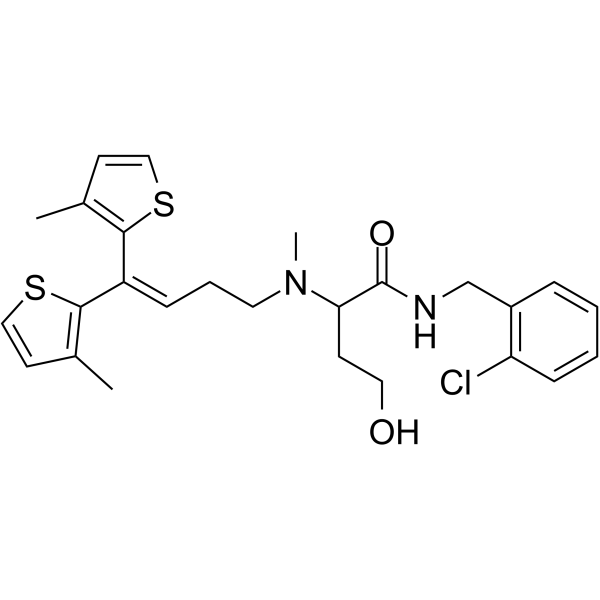
-
- HY-135195
-
|
|
GLP Receptor
|
Metabolic Disease
|
|
Boc5 is a non-peptidic glucagon-like peptide-1 receptor agonist. Boc5 causes sustained glycemic control and weight loss in diabetic mice. Boc5 can be used in research of diabetic .
|
-

-
- HY-116193
-
-
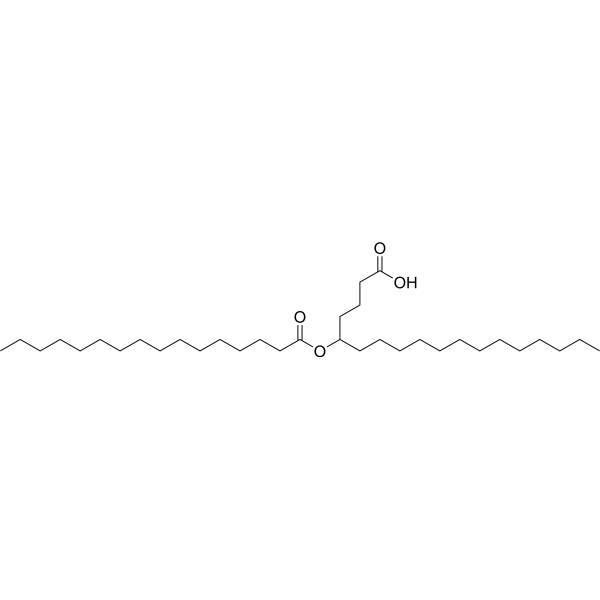
-
- HY-144231
-
|
|
Others
|
Metabolic Disease
|
|
SIK1 activator 1 exhibited remarkable inhibitory activity on hepatic gluconeogenesis by enhancing the SIK1 phosphorylation and ameliorated the hyperglyceamia of type 2 diabetic mice.
|
-

-
- HY-N0546
-
|
Nuezhenoside
|
CaSR
|
Metabolic Disease
|
|
Ligustroflavone, extracted from Ligustrum lucidum, is a potential candidate as calcium-sensing receptor (CaSR) antagonist. Ligustroflavone exhibits protective effects against diabetic osteoporosis in mice .
|
-
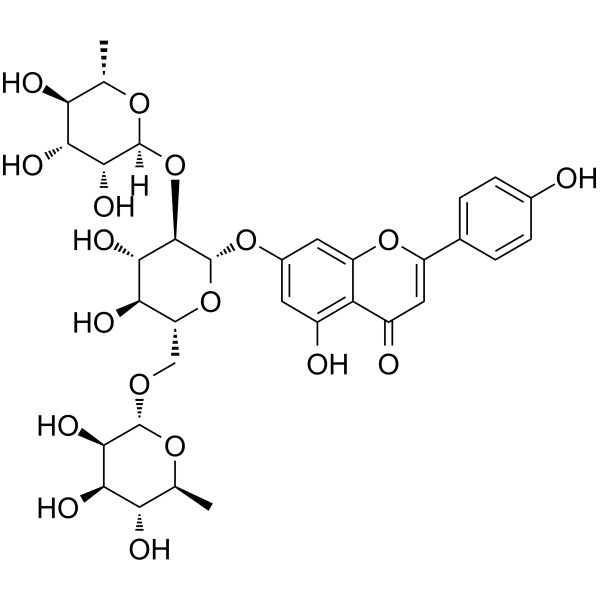
-
- HY-N3960
-
|
|
PPAR
Bacterial
|
Infection
Metabolic Disease
|
|
Glycyrin is a PPAR-γ ligand of licorice. Glycyrin can decrease the blood glucose levels of genetically diabetic mice. Glycyrin also shows antibacterial activity .
|
-

-
- HY-N3015
-
|
|
Others
|
Metabolic Disease
|
|
Bruceine E is a quassinoid from seeds of Brucea javanica (L.) Merr, exhibiting hypoglycemia effect . Bruceine E exhibits blood glucose lowering effect in both nondiabetic mice and Streptozotocin (STZ)-induced diabetic rats at lower dose .
|
-
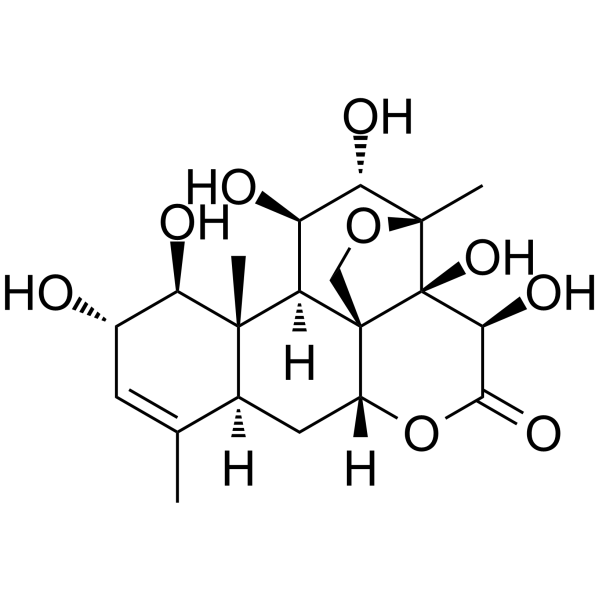
-
- HY-N9536
-
|
|
GLP Receptor
|
Metabolic Disease
|
|
Cinnamtannin A2, a tetrameric procyanidin, can increases GLP-1 and insulin secretion in mice. Cinnamtannin A2 could upregulate the expression of corticotrophin releasing hormone. Cinnamtannin A2 exhibits antioxidant, anti-diabetic and nephroprotective effect .
|
-
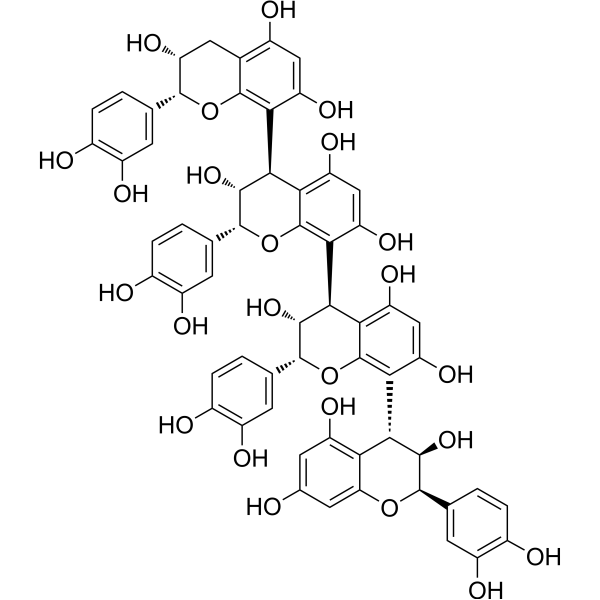
-
- HY-P3102
-
|
|
GCGR
|
Metabolic Disease
|
|
GLP-1(32-36)amide, a pentapeptide, derived from the C terminus of the glucoregulatory hormone GLP-1. GLP-1(32-36)amide could inhibit weight gain and modulate whole body glucose metabolism in diabetic mice .
|
-
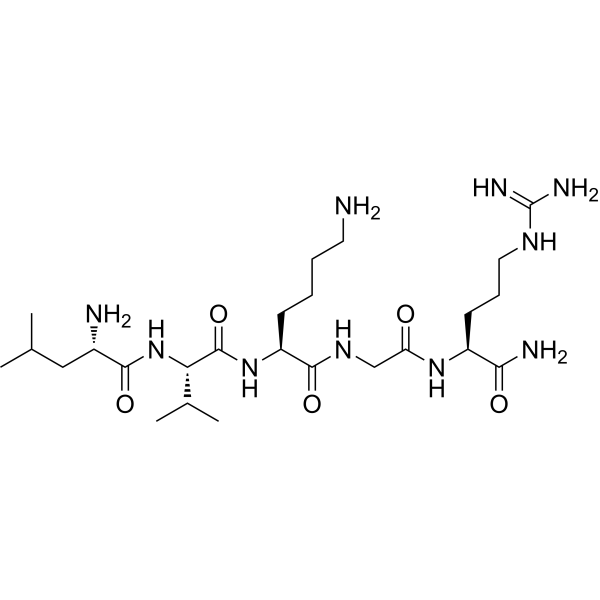
-
- HY-N11286
-
|
TG-DHA; Meganol D
|
Others
|
Neurological Disease
Metabolic Disease
Inflammation/Immunology
|
|
Tridocosahexaenoylglycerol (TG-DHA) is an orally active dietary supplement that improves autoimmune encephalomyelitis in mice. Tridocosahexaenoylglycerol shows beneficial effects on neurodegenerative diseases and also improves macular function in diabetic retinopathy. Tridocosahexaenoylglycerol can be used for research on neurological diseases, inflammatory immune diseases, and metabolic diseases .
|
-
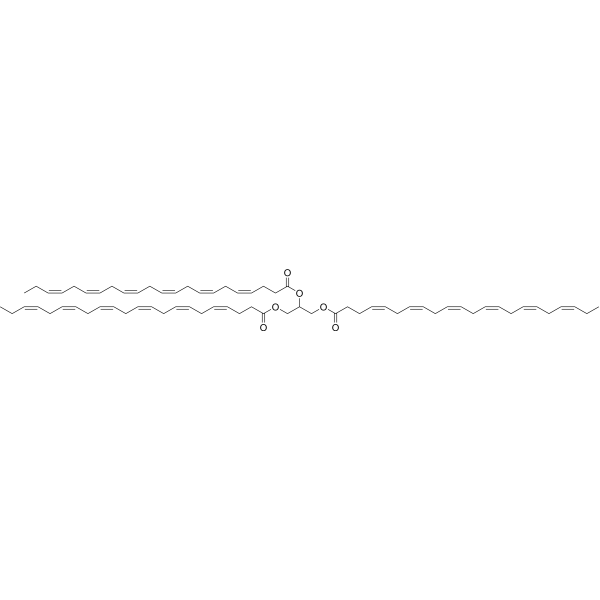
-
- HY-124373
-
|
|
MMP
|
Metabolic Disease
|
|
ND-336 is a selective inhibitor of matrix metalloproteinase (MMP)-2, MMP-9, and MMP-14, with Kis of 85, 150, and 120 nM, respectively. ND-336 accelerates diabetic wound healing in mice by lowering inflammation and by enhancing angiogenesis and re-epithelialization of the wound .
|
-
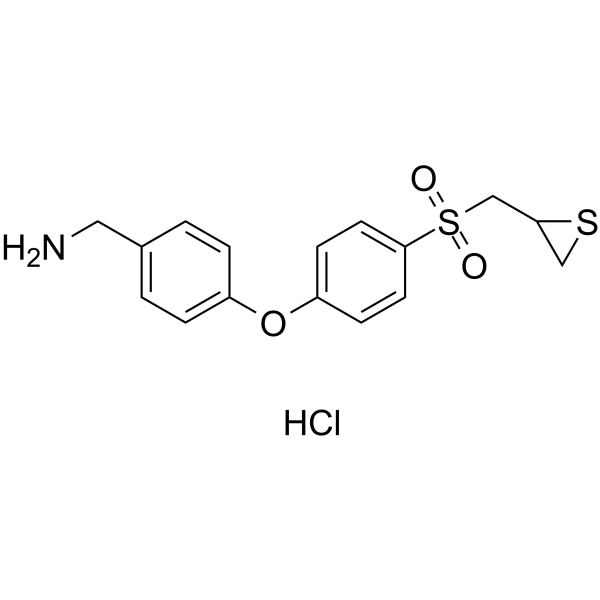
-
- HY-163066
-
|
|
Glucosidase
|
Metabolic Disease
|
|
α-Glucosidase-IN-44 (compound IT4) is an inhibitor of α-glucosidase with IC50 value of 2.35 μM. α-Glucosidase-IN-44 has an oral activity. α-Glucosidase-IN-44 suppresses fasting blood glucose levels in diabetic mice .
|
-

-
- HY-P3102A
-
|
|
GCGR
|
Metabolic Disease
|
|
GLP-1(32-36)amide TFA, a pentapeptide, derived from the C terminus of the glucoregulatory hormone GLP-1. GLP-1(32-36)amide TFA could inhibit weight gain and modulate whole body glucose metabolism in diabetic mice .
|
-

-
- HY-101064
-
|
N-FMOC-leucine; NPC 15199; NSC 334290
|
|
|
|
Fmoc-leucine is a selective PPARγ modulator. Fmoc-leucine activates PPARγ with a lower potency but a similar maximal efficacy than rosiglitazone. Fmoc-leucine improves insulin sensitivity in normal, diet-induced glucose-intolerant, and in diabetic db/db mice. Fmoc-leucine has a lower adipogenic activity .
|
-
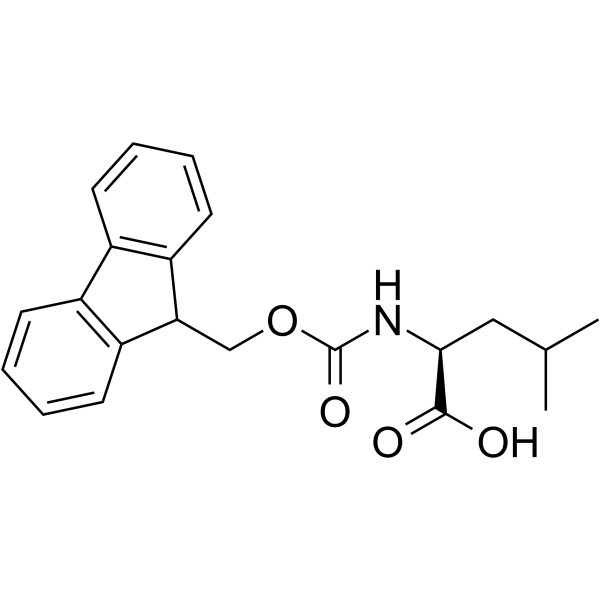
-
- HY-12611
-
|
GW-869682X
|
SGLT
|
Metabolic Disease
|
|
Sergliflozin etabonate (GW-869682X) is a potent and orally active sodium glucose cotransporter (SGLT2) inhibitor. Sergliflozin etabonate shows antidiabetic and antihyperglycemic effects. Sergliflozin etabonate significantly reduces non-fasting blood glucose levels in diabetic mice. Sergliflozin etabonate has the potential for the research of diabetes .
|
-
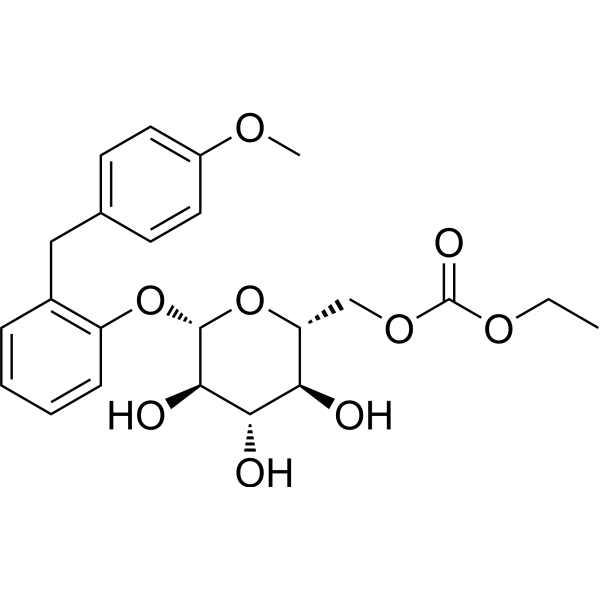
-
- HY-N5097
-
|
|
PPAR
|
Metabolic Disease
|
|
13-Oxo-9E,11E-octadecadienoic acid, an isomer of 9-oxo-ODA, is a potent PPARα activator derived from tomato juice. 13-Oxo-9E,11E-octadecadienoic acid decreases plasma and hepatic triglyceride in obese diabetic mice .
|
-
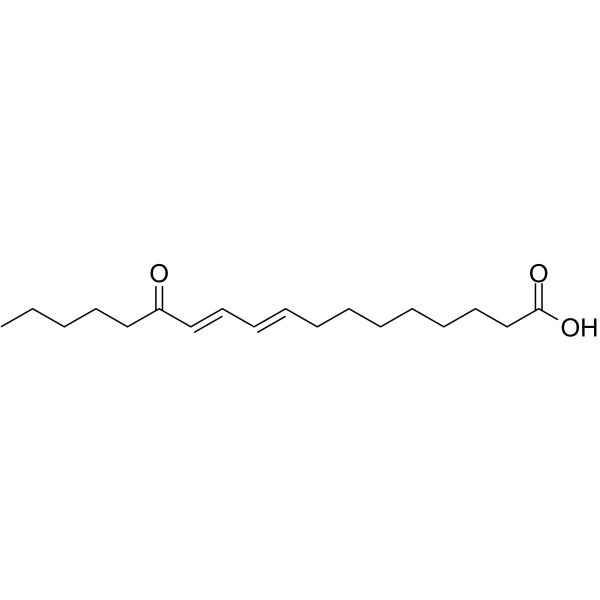
-
- HY-66009
-
-

-
- HY-119678
-
|
|
AMPK
Keap1-Nrf2
|
Cardiovascular Disease
Metabolic Disease
|
|
Fortunellin, is a flavonoid, that can be isolated from the fruits of Fortunella margarita (kumquat). Fortunellin exhibits little toxicity to mice and suppresses inflammation and ROS generation in H9C2 cells induced by LPS. Fortunellin protects against fructose-induced inflammation and oxidative stress by enhancing AMPK/Nrf2 pathway. Fortunellin can be used for diabetic cardiomyopathy research .
|
-

-
- HY-101064S2
-
|
N-FMOC-leucine-d3; NPC 15199-d3; NSC 334290-d3
|
PPAR
|
|
|
Fmoc-leucine-d3 is the deuterium labeled Fmoc-leucine. Fmoc-leucine is a selective PPARγ modulator. Fmoc-leucine activates PPARγ with a lower potency but a similar maximal efficacy than rosiglitazone. Fmoc-leucine improves insulin sensitivity in normal, diet-induced glucose-intolerant, and in diabetic db/db mice. Fmoc-leucine has a lower adipogenic activity[1].
|
-

-
- HY-101064S3
-
|
|
PPAR
|
|
|
Fmoc-leucine-d10 is the deuterium labeled Fmoc-leucine. Fmoc-leucine is a selective PPARγ modulator. Fmoc-leucine activates PPARγ with a lower potency but a similar maximal efficacy than rosiglitazone. Fmoc-leucine improves insulin sensitivity in normal, diet-induced glucose-intolerant, and in diabetic db/db mice. Fmoc-leucine has a lower adipogenic activity[1].
|
-

-
- HY-123297
-
|
|
Free Fatty Acid Receptor
|
Metabolic Disease
|
|
TUG-469 is a selective free fatty acid receptor 1 (FFA1/GPR40) agonist with an EC50 value of 19 nM. TUG-469 is >200-fold selective for FFA1 over FFA4. TUG-469 significantly improves glucose tolerance in pre-diabetic mice. TUG-469 can be used for the research of diabetes .
|
-
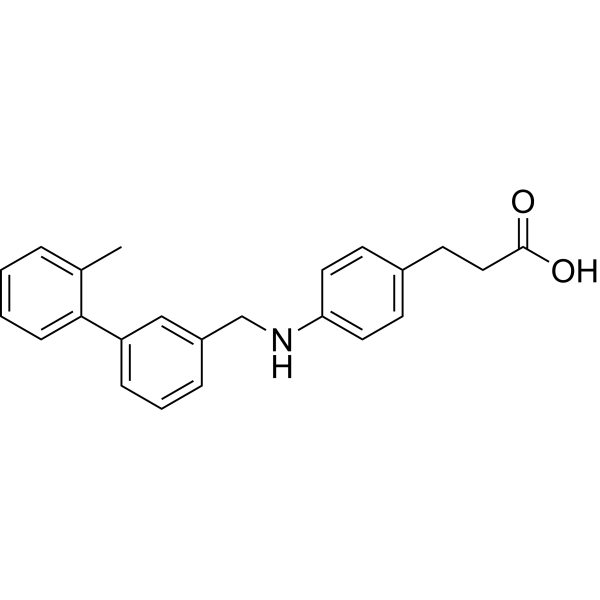
-
- HY-154985
-
|
|
PPAR
Bombesin Receptor
ERK
|
Metabolic Disease
|
|
DSO-5a is a potent, selective, orally active BB3 agonist. DSO-5a is a representative DMAKO-00 derivative compound. DSO-5a upregulates ppar-γ activity through BB3 and activates ERK1/2 phosphorylation. DSO-5a can be used in diabetes-related research .
|
-
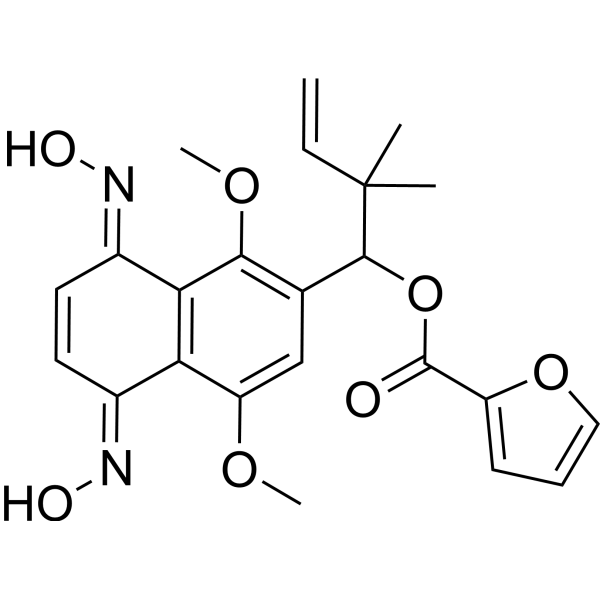
-
- HY-N6020A
-
|
|
Others
|
Others
|
|
(+)-Butin is the R enantiomer of Butin. Butin is a major biologically active flavonoid isolated from the heartwood of Dalbergia odorifera, with strong antioxidant, antiplatelet and anti-inflammatory activities .
|
-
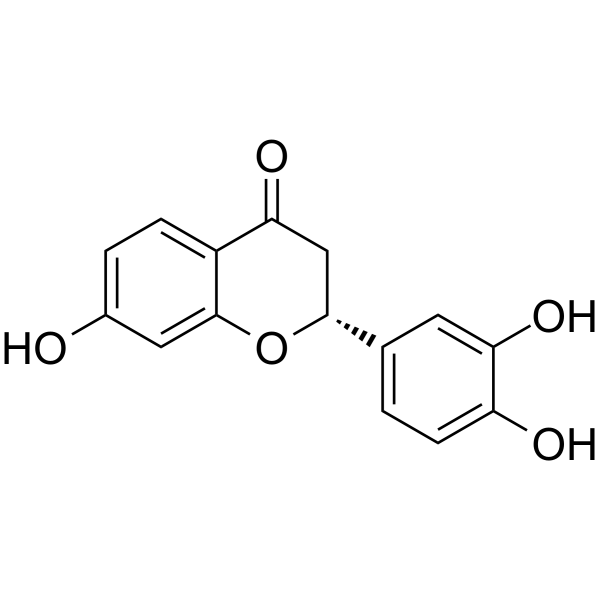
-
- HY-N11728
-
|
|
Amylases
Glucosidase
|
Metabolic Disease
|
|
2,7"-Phloroglucinol-6,6'-bieckol is an orally active dual α-amylase/α-glucosidase inhibitor with IC50 values of 6.94 μM and 23.35 μM respectively. 2,7"-Phloroglucinol-6, 6'-bieckol alleviates postprandial hyperglycemia in diabetic mice. 2,7"-Phloroglucinol-6,6'-bieckol can be used in diabetes research .
|
-
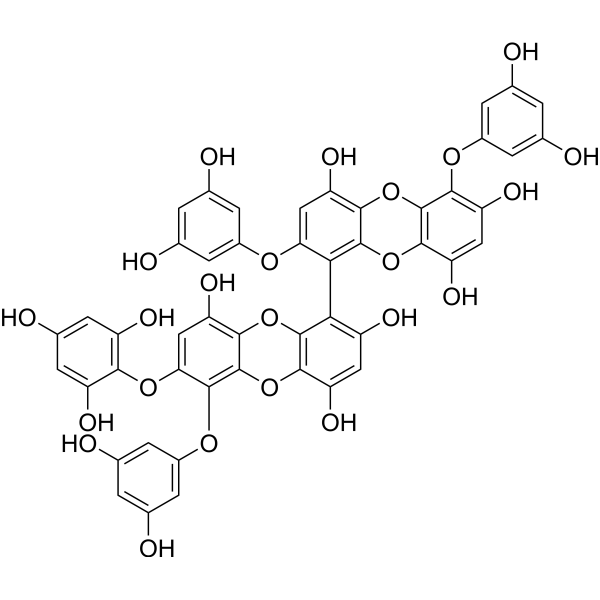
-
- HY-18555
-
TMPA
1 Publications Verification
|
Nuclear Hormone Receptor 4A/NR4A
AMPK
|
Metabolic Disease
Inflammation/Immunology
Cancer
|
|
TMPA is a high-affinity Nur77 antagonist that binds to Nur77 leading to the release and shuttling of LKB1 in the cytoplasm to activate AMPKα. TMPA effectively lowers blood glucose and attenuates insulin resistance in type II db/db, high-fat diet and streptozotocin-induced diabetic mice. TMPA reduces RICD (restimulation-induced cell death) in human T cells, can also be used in studies of cancer and T-cell apoptosis dysregulation .
|
-

-
- HY-122613
-
|
|
SGLT
|
Metabolic Disease
|
|
YM543 free base is a potent and orally active sodium-glucose cotransporter (SGLT) 2 inhibitor. YM543 free base reduces blood glucose levels. YM543 free base can be used in research of diabetes .
|
-
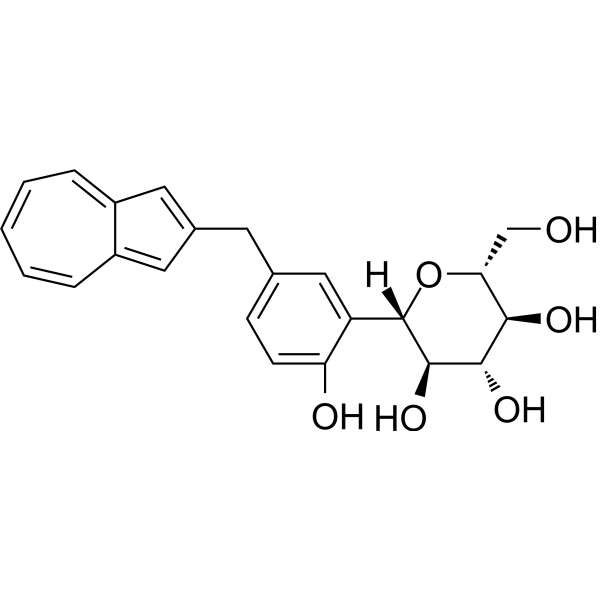
-
- HY-N0058
-
|
Isochlorogenic acid C
|
HBV
Endogenous Metabolite
Apoptosis
Glucosidase
|
Infection
|
|
4,5-Dicaffeoylquinic acid (Isochlorogenic acid C) is an antioxidant, can be isolated from Gynura divaricata and Laggera alata. 4,5-Dicaffeoylquinic acid reduces islet cell apoptosis and improves pancreatic function in type 2 diabetic mice, and has obvious inhibitory activities against yeast α-glucosidase. 4,5-Dicaffeoylquinic acid inhibits prostate cancer cells through cell cycle arrest. 4,5-Dicaffeoylquinic acid also has anti-apoptotic, anti-injury and anti-hepatitis B virus effects .
|
-

-
- HY-N1940
-
|
|
|
|
|
β-Anhydroicaritin is isolated from Boswellia carterii Birdware, has important biological and pharmacological effects, such as antiosteoporosis, estrogen regulation and antitumor properties . β-Anhydroicaritin ameliorates the degradation of periodontal tissue and inhibits the synthesis and secretion of TNF-α and MMP-3 in diabetic rats . β-Anhydroicaritin decreases the overproduction of NO, IL-10, TNF-α, MCP-1 and IL-6 in inperitonitis mice. β-Anhydroicaritin inhibits the elevation of intracellular Ca 2+, and markedly decreases iNOS protein expression .
|
-
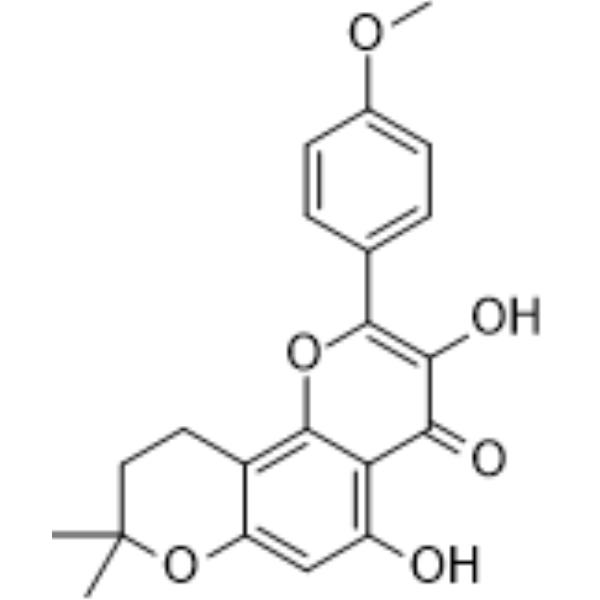
-
- HY-147678
-
|
|
Free Fatty Acid Receptor
|
Metabolic Disease
|
|
GPR40 agonist 5 (compound I-14) is an orally active and potent GPR40 (G protein coupled receptor 40) agonist, with an EC50 of 47 nM. GPR40 agonist 5 decreases the levels of blood glucose and improves the glucose tolerance. GPR40 agonist 5 has sufficient effectiveness for the control of hyperglycemia state in type 2 diabetic mice . GPR40 agonist 5 is a click chemistry reagent, it contains an Alkyne group and can undergo copper-catalyzed azide-alkyne cycloaddition (CuAAc) with molecules containing Azide groups.
|
-
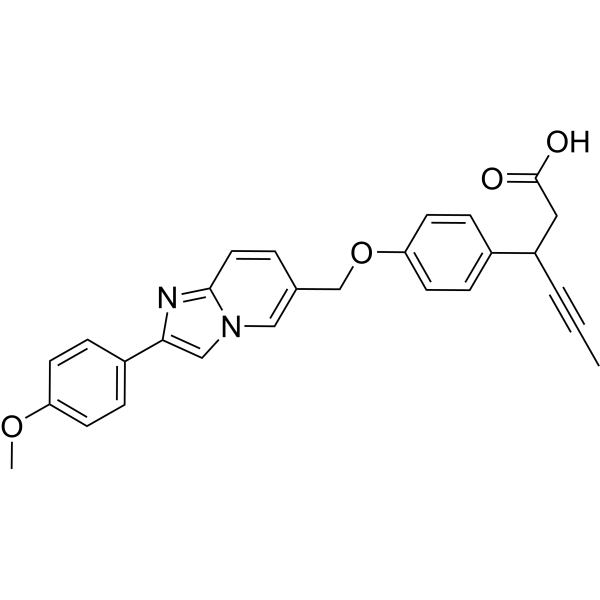
-
- HY-15648B
-
GSK-J4
Maximum Cited Publications
34 Publications Verification
|
Histone Demethylase
Apoptosis
|
Cancer
|
|
GSK-J4 is a potent dual inhibitor of H3K27me3/me2-demethylases JMJD3/KDM6B and UTX/KDM6A with IC50s of 8.6 and 6.6 μM, respectively. GSK-J4 inhibits LPS-induced TNF-α production in human primary macrophages with an IC50 of 9 μM. GSK J4 is a cell permeable proagent of GSK-J1 . GSK-J4 induces endoplasmic reticulum stress-related apoptosis .
|
-

-
- HY-15648F
-
|
|
Histone Demethylase
|
Cancer
|
|
GSK-J4 hydrochloride is a potent dual inhibitor of H3K27me3/me2-demethylases JMJD3/KDM6B and UTX/KDM6A with IC50s of 8.6 and 6.6 μM, respectively. GSK-J4 hydrochloride inhibits LPS-induced TNF-α production in human primary macrophages with an IC50 of 9 μM. GSK-J4 hydrochloride is a cell permeable proagent of GSK-J1 .
|
-

-
- HY-146281
-
-
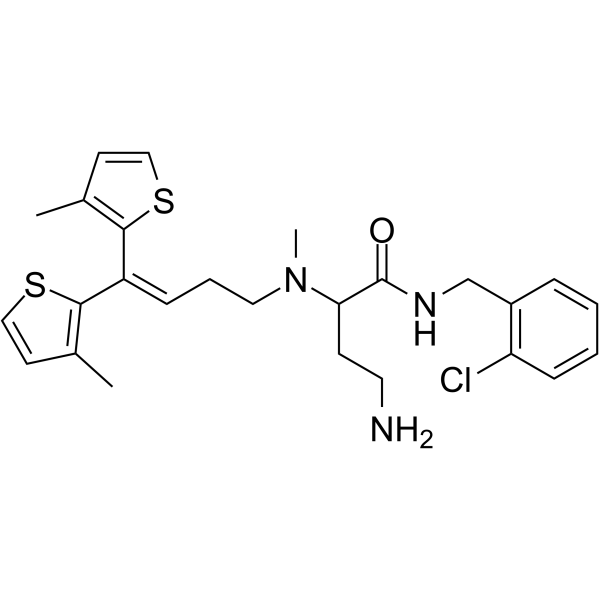
| Cat. No. |
Product Name |
Target |
Research Area |
-
- HY-103290
-
|
|
Bradykinin Receptor
|
Others
|
|
R715 is a selective bradykinin B1 receptor antagonist. R715 significantly attenuates the hyperalgesic effect developed in Streptozotocin(HY-13753)-diabetic mice .
|
-
- HY-P3102
-
|
|
GCGR
|
Metabolic Disease
|
|
GLP-1(32-36)amide, a pentapeptide, derived from the C terminus of the glucoregulatory hormone GLP-1. GLP-1(32-36)amide could inhibit weight gain and modulate whole body glucose metabolism in diabetic mice .
|
-
- HY-P1910
-
|
|
Peptides
|
Metabolic Disease
|
|
BDC2.5 mimotope 1040-51 is a mimotope peptide for diabetogenic T cell clone BDC2.5. isolated from non-obese diabetic mice .
|
-
- HY-P5489
-
|
|
Peptides
|
Others
|
|
IGRP(206-214) is a biological active peptide. (This peptide corresponds to residues 206–214 of murine islet-specific glucose-6-phosphatase catalytic subunit–related protein (IGRP). This peptide is T cells specific for proinsulin and IGRP induces diabetes in non-obese diabetic (NOD) mice.)
|
-
- HY-P3102A
-
|
|
GCGR
|
Metabolic Disease
|
|
GLP-1(32-36)amide TFA, a pentapeptide, derived from the C terminus of the glucoregulatory hormone GLP-1. GLP-1(32-36)amide TFA could inhibit weight gain and modulate whole body glucose metabolism in diabetic mice .
|
-
- HY-P5396
-
|
|
Peptides
|
Others
|
|
GAD65 (524-543) is a biological active peptide. (This is amino acids 524 to 543 fragment of glutamic acid decarboxylase 65 (GAD65). It is one of the first fragments of this islet antigen to induce proliferative T cell responses in the non-obese diabetic (NOD) mouse model of spontaneous autoimmune diabetes. This peptide is a specific, possibly low affinity, stimulus for the spontaneously arising diabetogenic T cell clone BDC2.5. Immunization with p524–543 increases the susceptibility of the NOD mice to type 1 diabetes induced by the adoptive transfer of BDC2.5 T cells.)
|
| Cat. No. |
Product Name |
Category |
Target |
Chemical Structure |
| Cat. No. |
Product Name |
Chemical Structure |
-
- HY-101064S2
-
|
|
|
Fmoc-leucine-d3 is the deuterium labeled Fmoc-leucine. Fmoc-leucine is a selective PPARγ modulator. Fmoc-leucine activates PPARγ with a lower potency but a similar maximal efficacy than rosiglitazone. Fmoc-leucine improves insulin sensitivity in normal, diet-induced glucose-intolerant, and in diabetic db/db mice. Fmoc-leucine has a lower adipogenic activity[1].
|
-

-
- HY-101064S3
-
|
|
|
Fmoc-leucine-d10 is the deuterium labeled Fmoc-leucine. Fmoc-leucine is a selective PPARγ modulator. Fmoc-leucine activates PPARγ with a lower potency but a similar maximal efficacy than rosiglitazone. Fmoc-leucine improves insulin sensitivity in normal, diet-induced glucose-intolerant, and in diabetic db/db mice. Fmoc-leucine has a lower adipogenic activity[1].
|
-

Your information is safe with us. * Required Fields.
Inquiry Information
- Product Name:
- Cat. No.:
- Quantity:
- MCE Japan Authorized Agent:











































